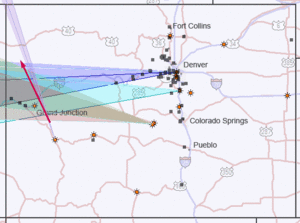
|
| ©Cloudbait |
| Captured image of meteorite that produced sonic booms in the Rockies. |
The image above is from the Cloudbait camera. The bright spot just north of the meteor is the setting Moon, which at a 20% phase had a magnitude of -8.3. The meteor is clearly much brighter than this.
Multistation analysis of the event shows that the meteor began above Delta, CO, at a height of 97 km (60 miles) and ended over empty country about 15 miles south of Rangely, CO, at a height of 41 km (26 miles). It had a 140 km (88 mile) ground path. The meteor descended at an angle of 21.6° from horizontal, with an initial velocity of 23.5 km/s (53,000 mph) and a final velocity at breakup of 17.3 km/s (39,000 mph). The velocity profile is consistent with a 450 kg (1000 lb) stony body approximately 60 cm in diameter (~ 2 feet). The ground path is shown on the map below. Witnesses as of midday April 23 are shown as small black squares.

|
| ©Cloudbait |
| Map of trajectory. |
The meteor's radiant was RA 204°, dec -23°, in Hydra bordering Virgo. This is fairly close to the diffuse radiant of a family of showers called the April Virginid Complex. These related minor showers are poorly characterized, and it is not possible to say with certainty if this fireball was related to them or was sporadic, although the latter is more likely. April 20-22 marks the peak of the annual Lyrid meteor shower, and some stories in the press have reported this event as a Lyrid. This is definitely not the case; it is purely coincidental that this fireball occurred during the Lyrids.
The meteor began fragmenting as it crossed I-70 between Akin and Palisade. Witnesses in Grand Junction and Fruita reported sonic booms following the event. The combination of acoustics, low entry angle, relatively low speed, and multiple fragmentations at low altitude make it likely that meteorites were produced. If so, they probably fell near the northern end of the path, in countryside that is rugged and largely uninhabited.



Reader Comments
to our Newsletter